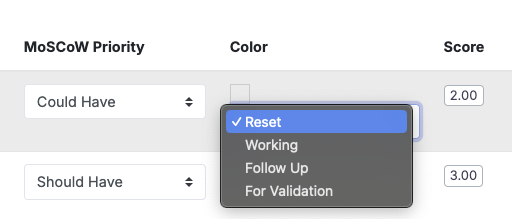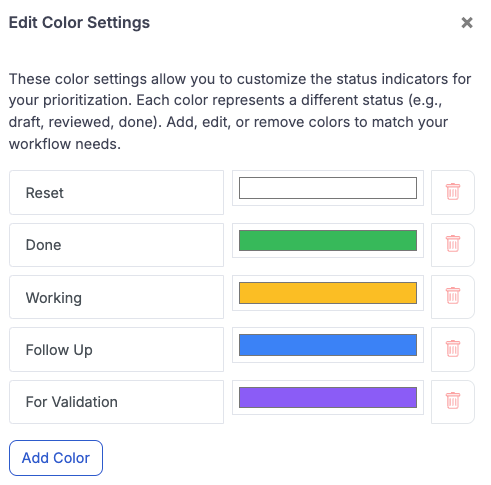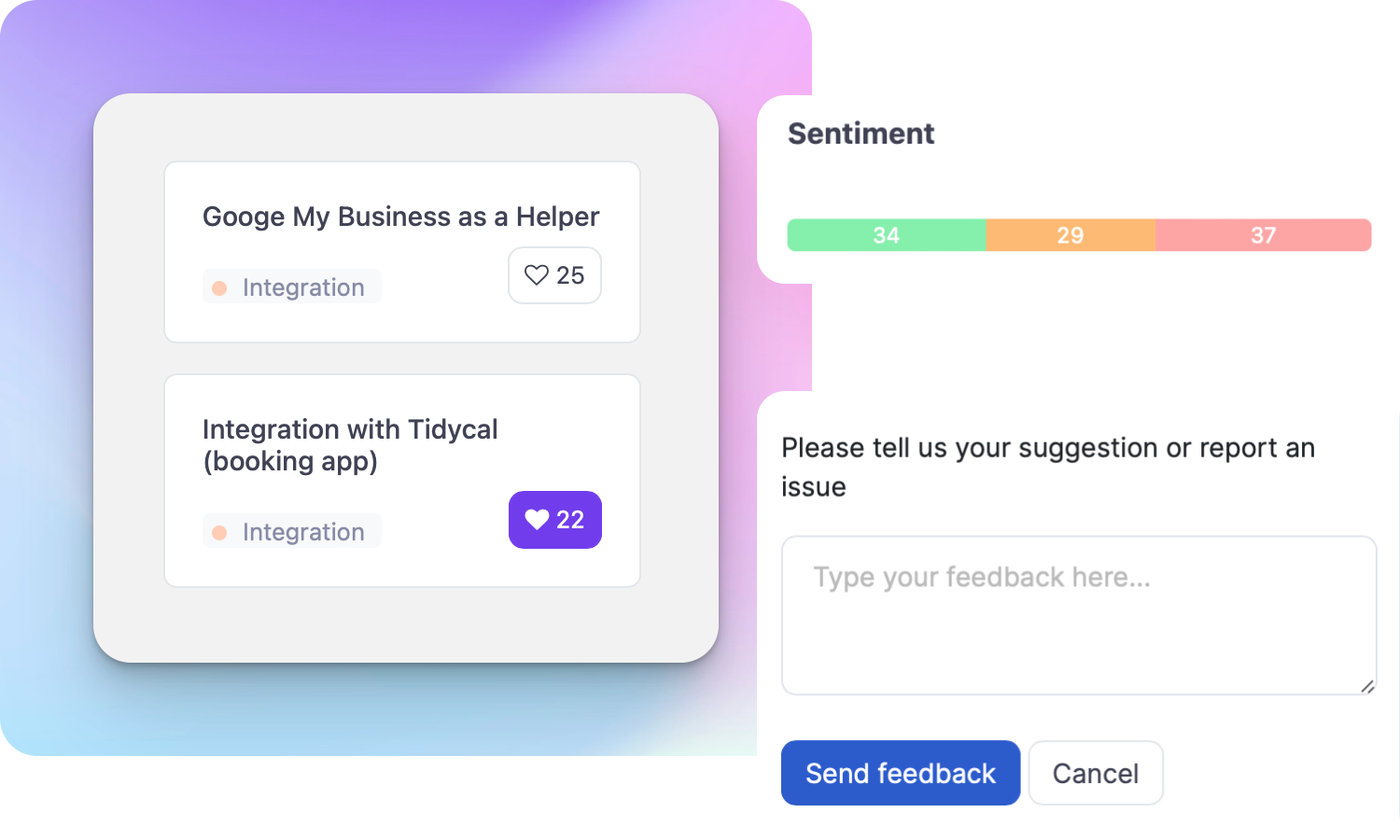What is MoSCoW Prioritization? All You Need to Know

Ruben Buijs
Prioritization is super important in product management. You can only spend your time once, so you need to make sure you're doing the right things.
In my 10 years of consulting at Accenture and Ernst & Young, I've seen a lot of companies struggle with this.
Often, I've watched product managers make decisions based on gut feelings or who shouts the loudest (usually the boss). But that's not the best way to do business. You want a more objective way to set priorities.
That's where frameworks like MoSCoW come in handy. I'll walk you through this simple but powerful prioritization method, sharing my tips and tricks along the way.
What is MoSCoW Prioritization?
MoSCoW is a prioritization technique that categorizes tasks or features into Must have, Should have, Could have, and Won't have (this time) to help teams focus on what's most important when time and resources are limited.
MoSCoW is a simple way to decide what’s most important in your project. By sorting tasks, features, or requirements into four categories—Must have, Should have, Could have, and Won't have—you can focus on what really matters first.
In Agile, MoSCoW helps teams manage their backlogs, plan sprints, and clearly communicate priorities to everyone involved. It’s a versatile tool that makes decision-making easier by giving you a clear way to judge what’s important.
History and Origin of MoSCoW
MoSCoW prioritization has its roots in the Agile methodology. It was developed in the late 1990s by Dai Clegg at Oracle to help teams prioritize requirements in software development projects. The name MoSCoW comes from the first letters of four categories:
-
Must have
-
Should have
-
Could have
-
Won't have (this time)
The extra "o"s are just there to make the word pronounceable, like "Moscow." Over time, MoSCoW has grown beyond software development and is now used in many industries for effective prioritization.
Understanding where MoSCoW came from helps you see why it's so widely used and how it can fit into different project environments.
Breaking Down MoSCoW
Let’s look closer at each part of MoSCoW:
-
Must Have
These are essential requirements. Without them, the project won't work. Think of them as non-negotiable elements like core functionalities or compliance needs.
-
Should Have
These are important but not critical. They add significant value but can be delayed if necessary. Examples include enhancements or features that improve user experience.
-
Could Have
These are nice-to-have items. They’re not essential and can be added if there’s extra time and resources. This might include aesthetic improvements or additional features that are not crucial.
-
Won't Have (this time)
These are items you decide to leave out for now. They might be planned for future releases or optional enhancements. This helps keep the project scope manageable.
How to Use MoSCoW
Using MoSCoW is straightforward. Here’s how I like to do it:
First, list everything you need for your project. This could be ideas, features, or tasks. Make sure to include input from different team members to cover all perspectives.
Take your time to make a good list. It's a pain when you're halfway through prioritizing and someone throws in a new idea. I usually ask customers, partners, and coworkers for their input using surveys or a feedback tool.
Let's add the list in the Score-based Prioritization module:
Next, sort each item into one of the four MoSCoW categories. This helps you see what’s most important right away. For example, if you're using ProductLift, you can assign each feature to a MoSCoW category. ProductLift will then help you sort these automatically based on their priority.
After sorting, check to make sure you haven’t put too many items in the "Must Have" category. I aim for no more than 60% of the effort to be on Must Haves. This balance ensures you have room for Should Haves and Could Haves.
You can find the MoSCoW distribution at the top of the prioritization list.
When validating scores with stakeholders or clients, you can use the color field.
These are configurable to match your workflow.
The end result looks something like this.
Now, start working on the Must Haves first. Once those are done, move on to the Should Haves, and then tackle the Could Haves if you have the time and resources.
Finally, keep reviewing and updating your priorities as the project progresses. What’s a Must Have today might become a Could Have tomorrow as new information comes in.
You can also use our MoSCoW Excel template to do a quick prioritization.
Practical Examples and Case Studies
Case Study: Software Development Project
Imagine a software company developing a Minimum Viable Product for a new project management tool. They need to prioritize features to ensure a successful launch.
This is how I would set the MoSCoW priority:
Must Have: Task creation, task assignment, and deadline tracking. These are essential for the tool to function and ensure basic project management capabilities.
Should Have: Basic reporting and user roles and permissions. These add value by providing insight into project progress and offering access control, but they aren't critical for the MVP.
Could Have: Collaboration features (comments, file sharing), customizable workflows, and time tracking for tasks. These enhance team communication and flexibility, but aren’t necessary for the initial functionality.
Won't Have (this time): Integration with third-party apps, advanced analytics, and Gantt charts. These features are planned for future updates and are left out to keep the launch focused and manageable.
By using MoSCoW, the team ensures that the essential features are ready for launch while planning to add more value in future updates.
Common Pitfalls and How to Avoid Them
Using MoSCoW can be very effective, but there are some common mistakes to watch out for:
One mistake is putting too many items in the "Must Have" category. This can make the project overwhelming and lead to missed deadlines. To avoid this, aim to keep Must Haves around 60% of your total effort.
Another pitfall is not involving all stakeholders in the prioritization process. If only a few voices are heard, the priorities might not reflect what’s truly important for everyone. Make sure to include input from different team members and stakeholders to get a balanced view.
Sometimes, teams forget to review and update their priorities regularly. Projects can change, and what was a Must Have before might become a Should Have later. Schedule regular check-ins to adjust your priorities as needed.
Lastly, avoid being too rigid with your categories. Flexibility is key. If new information comes in, be ready to shift items between categories to stay on track with your project goals.
Involving Stakeholders in the MoSCoW Process
Getting everyone involved in prioritization makes the process smoother and the results better. Here’s how to do it:
Start by gathering all stakeholders, including team members, managers, and even customers if possible. Present the list of tasks or features and explain the MoSCoW categories.
Encourage open discussion about each item's importance. This helps ensure that everyone's views are considered and that the priorities reflect the needs of the whole group.
Use tools like ProductLift to visualize the prioritization. When everyone can see how items are categorized, it’s easier to agree on what's important.
Regularly communicate updates to keep everyone on the same page. This transparency helps maintain trust and ensures that priorities remain aligned with the project’s goals.
By involving stakeholders, you create a collaborative environment where everyone is committed to the project’s success.
Integration with Other Project Management Methodologies
MoSCoW works well with other project management methods like Scrum, Kanban, and Lean. Here’s how you can integrate it:
In Scrum, use MoSCoW during sprint planning to decide which tasks to include in each sprint. This ensures that the most important items are tackled first.
With Kanban, apply MoSCoW to manage your workflow by prioritizing tasks in your Kanban board. This helps you focus on high-priority tasks while keeping lower-priority ones in view.
In Lean, MoSCoW can help you eliminate waste by focusing only on the most valuable tasks. This aligns well with Lean’s emphasis on efficiency and value.
Using MoSCoW alongside these methods enhances their effectiveness by providing a clear prioritization framework, ensuring that your team always focuses on what matters most.
Advanced Techniques and Customizations
While MoSCoW is simple, you can customize it to fit your needs better. Here are some advanced tips:
Add sub-categories to each MoSCoW category for more detail. For example, within "Should Have," you might have "High Priority" and "Low Priority" items.
Combine MoSCoW with scoring systems to give each item a numerical value based on factors like impact and effort. This adds another layer of prioritization and helps in making more informed decisions.
Use color-coding or tags in your project management tool to easily identify the priority of each item. This visual aid can make it quicker to assess and adjust priorities.
By tailoring MoSCoW to your specific project, you can make it even more effective and ensure it meets your unique needs.
Measuring the Effectiveness of MoSCoW
To ensure MoSCoW is working well for your project, you need to measure its effectiveness. Here’s how:
Set clear goals for what you want to achieve with MoSCoW, such as faster decision-making or better stakeholder alignment.
Use metrics like the number of tasks completed on time, the satisfaction of stakeholders, and the overall progress of the project to gauge success.
Gather feedback from your team and stakeholders regularly. Ask them if the prioritization is helping them focus and if the categories make sense.
Analyze the results and make adjustments as needed. If certain categories are consistently overloaded or underutilized, tweak your approach to better balance the workload.
By measuring how well MoSCoW is working, you can continuously improve your prioritization process and ensure your project stays on track.
Handling Changing Requirements with MoSCoW
Projects often change, and your priorities might need to shift as well. Here’s how to handle changes with MoSCoW:
Stay flexible and be ready to move items between categories as new information comes in. For example, a feature that was a "Could Have" might become a "Should Have" if user feedback shows it's important.
Regularly review your priorities to ensure they still align with the project’s goals and any new requirements. This helps you stay adaptable and responsive to changes.
Communicate any changes to your team and stakeholders clearly. Make sure everyone understands why priorities are shifting and what the new focus is.
Use tools like ProductLift to easily update and visualize changes in your priorities. This makes it easier to manage adjustments and keep everyone informed.
By staying flexible and proactive, you can handle changing requirements effectively without losing focus on what’s most important.
MoSCoW vs. RICE
You might be wondering how MoSCoW compares to other prioritization methods like RICE. Here’s a simple comparison:
MoSCoW is simpler and quicker to use. It’s great when you need to make fast decisions or don’t have a lot of data.
RICE stands for Reach, Impact, Confidence, and Effort. It’s more detailed and better when you have more information about your users and need a more nuanced approach.
In my experience, MoSCoW works well for smaller projects or when you need to make quick calls. RICE is better for larger projects or when you’re planning for the long term and need more detailed prioritization.
Choosing between MoSCoW and RICE depends on your project’s needs and the level of detail you require in your prioritization process.
MoSCoW vs. Additional Prioritization Frameworks
Besides RICE, there are other frameworks like Kano, WSJF (Weighted Shortest Job First), and Value vs. Effort matrices. Here’s how MoSCoW stacks up:
-
Kano Model: Focuses on customer satisfaction and classifies features based on their ability to satisfy users. MoSCoW is more straightforward and focuses on prioritizing based on necessity and value.
-
WSJF: Used in Lean and Agile for prioritizing jobs based on cost of delay and job duration. MoSCoW is simpler and easier to apply without needing detailed calculations.
-
Value vs. Effort: Plots features on a grid to balance their value against the effort required. MoSCoW categorizes features into Must, Should, Could, and Won’t, which is more about setting priorities than balancing value and effort.
Each framework has its strengths, and sometimes combining them can give you the best results. MoSCoW is great for its simplicity and ease of use, making it a solid choice for many projects.
Measuring the Effectiveness of MoSCoW
To ensure MoSCoW is working well for your project, you need to measure its effectiveness. Here’s how:
Set clear goals for what you want to achieve with MoSCoW, such as faster decision-making or better stakeholder alignment.
Use metrics like the number of tasks completed on time, the satisfaction of stakeholders, and the overall progress of the project to gauge success.
Gather feedback from your team and stakeholders regularly. Ask them if the prioritization is helping them focus and if the categories make sense.
Analyze the results and make adjustments as needed. If certain categories are consistently overloaded or underutilized, tweak your approach to better balance the workload.
By measuring how well MoSCoW is working, you can continuously improve your prioritization process and ensure your project stays on track.
Frequently Asked Questions
What is the MoSCoW Prioritization Model?
The MoSCoW Prioritization Model is a technique used in product management to prioritize the requirements or features of a product based on their importance.
What does MoSCoW stand for?
MoSCoW is an acronym that stands for Must have, Should have, Could have, and Won't have.
How does the MoSCoW Prioritization Model work?
The MoSCoW Prioritization Model categorizes requirements or features into four priority levels: Must have, Should have, Could have, and Won't have. This helps in making decisions about what needs to be included in a product.
What are 'Must have' requirements or features?
'Must have' requirements or features are the ones that are absolutely necessary for the product to function properly. These are the highest priority items.
What are 'Should have' requirements or features?
'Should have' requirements or features are important but not critical for the product. They can be deferred if necessary, but it is preferred to include them.
What are 'Could have' requirements or features?
'Could have' requirements or features are desirable but not essential for the product. These can be included if there is enough time and resources.
What are 'Won't have' requirements or features?
'Won't have' requirements or features are explicitly decided to be excluded from the product. These are low priority items that are not considered for implementation.
Who should use the MoSCoW Prioritization Model?
The MoSCoW Prioritization Model can be used by product managers, development teams, and stakeholders involved in the product management process to prioritize and make informed decisions.
What are the benefits of using the MoSCoW Prioritization Model?
Using the MoSCoW Prioritization Model helps in clarifying priorities, focusing on essential features, managing scope, and making trade-off decisions effectively.
Are there any limitations to the MoSCoW Prioritization Model?
Yes, the MoSCoW Prioritization Model does not provide a precise measurement of priority or effort. It is a subjective technique that relies on the judgment of stakeholders.
Wrapping Up
MoSCoW prioritization is a handy tool in your product management toolkit. It's quick, simple, and gets the job done. While it might not be as detailed as some other methods like RICE, it's perfect for when you need to make fast decisions or communicate priorities clearly.
Remember, the best prioritization method is the one that works for you and your team. Whether you choose MoSCoW, RICE, or something else entirely, the goal is always the same: focus on what matters most to move your product forward.
Give MoSCoW a try in ProductLift and see how it works for you. Happy prioritizing!







